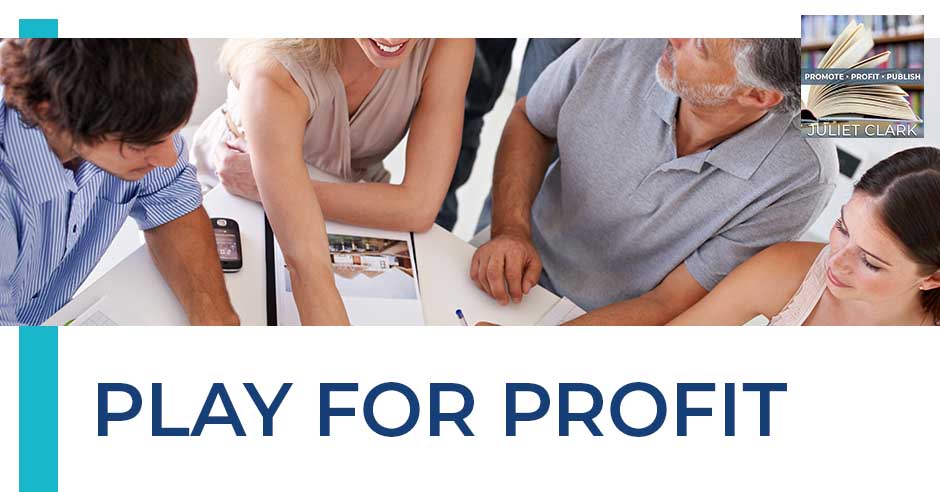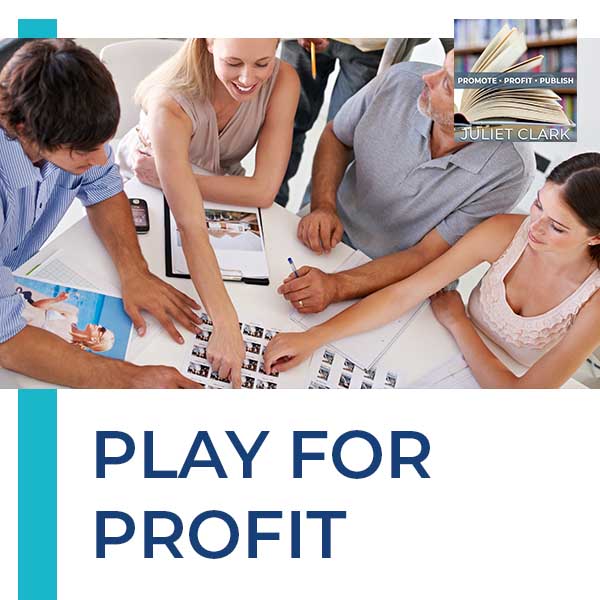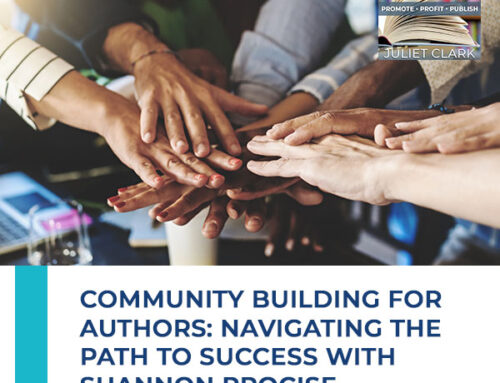
How can you keep your team working together not just productively but also in a fun and exciting way? Perhaps if they can play for profit, things would go much more positively. Nancy Mayer, strategic planning consultant and author of The Advisory Board Playbook, is here to share several facilitation tools and gamification strategies to make this possible. Joining Juliet Clark, she talks about various tactics that can help bring every individual in a team to the same page, all while celebrating small wins along the way. Nancy also talks about the advantage of knowing your ideal customer to hone better strategies that would prove useful to your target audience.
—
Watch the episode here
Listen to the podcast here
Play For Profit
Full disclosure, this episode’s guest is an actual, and not just somebody I do business with, but a friend. She’s one of my golf buddies. We both suck at it, but we love it and she’s a very avid skier too. I will introduce her in a moment. I want to remind you to go over and check out the book club. It’s BreakthroughAuthorsBookClub.com.
Our guest is going to be one of the featured books. You’ll get to preview her book and also, Breakthrough Author Magazine. You can go get it at BreakthroughAuthorMagazine.com. Our theme this year is Ditch the Middleman Strategies to Bypass that 55% Distributor Fee. It’s keeping more money in your pocket from your book because if you’ve published a book lately, you probably are only getting $1 or $2 out of it. We want to maximize those ways for you to keep more in your pocket.
Our guest is Nancy Mayer and she is not your typical strategic planning consultant with a knack for shaking things up. She’s carved out a niche as the go-to rebel for organizations ready to challenge the status quo. Merging her proudness, and design thinking visual storyteller and gamification, Nancy crafts strategies that aren’t just innovative. They’re downright revolutionary. A thought leader, author, and relentless innovator, she believes in pushing boundaries and redefining possibilities with an unapologetic drive. Nancy is on a mission to propel organizations from the mundane to the extraordinary one game-changing move at a time. Welcome, Nancy.
Thank you, Juliet. Yes, we are good friends.
The Advisory Board Playbook
The book is part of the free giveaway in this episode. I have to tell you guys. Nancy has a book called The Advisory Board Playbook and she is going to talk about some concepts that might seem like they’re a little over your head because they are revolutionary. However, rest assured, we are going to give you a URL at the very end that’ll bring it all together and it is going to download the third part of her book, which is more of the implementation. Just be aware of that if you feel like you’re a little confused by this interview. Nancy, welcome.
Thank you so much. I’m excited to be here. I did write the book, The Advisory Board Playbook and Juliette is my publisher. We have been having a lot of fun doing it. The book is in three parts. It’s what an advisory board is and isn’t. The second part is my five-step process for building advisory boards. The third one is now that you’re going to have this meeting, it’s very important that you do it right.
When you have those many people around the table, you want to make sure that you optimize the time that you have with them. That’s where we’re going to deep dive today in that facilitation, games, and strategy tactics. Also, getting everybody on the same page. I’m a big proponent of one-page solutions. The last part of the book is it’s four different types of advisory boards.
You have a strategic advisory board, which is more for business and strategy. You have a customer advisory board that helps you get feedback from your customers in a very fun, innovative, and playful way. There are not-for-profit advisory boards, but I believe people can be much more strategic about bringing the right people to the table and understanding that it is a voluntary position and the expectations are different.
Finally, like a peer advisory board, which is in my mind, those old-style masterminds where you have 7 or 8 people who are committed to each other who get together and that’s where you see more of the hot seats and things like that. All the different techniques are in the book, but in particular, we’re going to delve into the whole facilitation piece because I think everybody here is not only are author but are speaker. I think there are some fun ways to integrate games and play into your talks and your interactions with your customers to grow faster and get innovative solutions to whatever your biggest challenges are. It’s all around strategy.
Nancy, I could have used you last time. We had our first meeting for an initiative and seven people in there. About three of them showed up with a different vision. Even though I had talked to them in advance, it was very illuminating. We had to pull back and somebody contacted me and they said, “I felt so bad for you because some people were bringing other things to the table.” What was interesting about it is I love what you’re talking about because you could see power plays were going on with my idea.
I was a little bit offended and a little bit overwhelmed because it didn’t go where we thought. We had to pull back. We created a survey this week and so now we’re going to look at the survey answers and figure out who’s good for this and who’s not. Sometimes when you get all those people in a room, they’re not on board. You and I had the same thing happen a couple of years ago. We brought a group of people together at your house. We put together this great plan and then the leader didn’t execute it.
Facilitation Tools
I’m going to go through a variety of some of my favorite facilitation tools. One of them that I highly recommend is called Liberating Structures. It’s this way to create a structure without creating a structure. There are about twelve different games or exercises that are in the book Liberating Structures but you can go to the website and then there are quite a few more. However, there’s one that I agree with, which is PPP. If you go to Liberating Structures, it’s a great way to go through all the different steps so that everybody is on the same page with the plan and the purpose of an organization like yours.
What are some of the other ones that you put together? It sounds like we were trying to use the Liberating Structures without knowing what one was.
Liberating Structures is another framework because a lot of these are different frameworks. It is called the storyboard. In the storyboard, it allows you to use different elements of liberating structures to build out a meeting. Depending on the outcomes that you want for the meeting, then you can reverse engineer and look at the different exercises, games, or processes that you can go through to get you those actionable results.

Play For Profit: Use a storyboard to plot different elements of liberating structures to build out a meeting.
Also, getting everybody again on the same page because the P2P is one page you end up with going through everything. Liberating Structures is great. One of my other favorite ones is Innovation Games. Innovation Games is early-stage marketing research. There’s Discovery Games. Literally, within an hour you can uncover the number one problem that if you solve will give you the biggest bang for your buck.
There are Shaping Games where you get your customers to tell you what are the must-haves and what are the nice-to-haves. What I love about shaping games is that there are a lot of blanks that allow them to give you ideas that you wouldn’t otherwise see because I find sometimes we become overly sophisticated consumers of our own product and we think things are intuitive and they might not be to our customers.
Sometimes, we become overly sophisticated consumers of our own products that we think things are intuitive but not for our customers. Share on XYou and I were talking about Notion and I thought that was such a great platform because it was intuitive for me. Yet, if I were to hand my notion to you, it may not be intuitive for you. That is such a great point in that way your mind works that if you don’t understand the way your client’s mind works, you may be creating something that is off-kilter for them.
Gamification And Collaboration
I’ll finish up on that and then we’ll talk about canvases because you brought up a great point about understanding your customers and how you add value. The last innovation game that I love using is prioritization games. Very often if you have a tech company or if you’re building different products, you have new features and things that you were thinking about putting out, but you don’t know what’s going to drive the highest value for your customers.
Your T-shirt size how expensive it’s going to be to develop this new piece of software or this new product. Also, based on the T-shirt size, you give it an arbitrary number. A small might be $5, an extra-large might be $25. You then add it all up and you give your customers about 45% of that budget and they’re going to tell you very quickly what drives the highest value for them by what they purchased.
Now, the interesting thing about gamification and play is it’s a dopamine release. Those clients have a dopamine release when they buy something virtually and it increases their propensity to buy it when you put the product out because they want to replicate that feeling. In between a lot of games, these exercises, and dopamine releases, are what drive gamification.
Most people when they think of gamification, they think of rewards. You do this and you get this reward and there are a lot of loyalty programs, challenges, and achievement rewards that are based on that. There’s the next level of gamification, which is when you do collaborative games. Innovation games are in that collaborative game realm. The last one, which is much more difficult to design is more of those interactive games where you’re playing a certain role in a safe space, and at the end it’s that idea of how did you play?
Business Model Canvas And Value Proposition Canvas
It allows you to make mistakes in a safe environment so that when you go out into the real world, you’ve had some experience. As we all know, you do one thing once and it’s scary and then you do it again. Each time you do it, it becomes less and less scary. Going back to thinking about your customers and how they think, I’m a big fan of the business model canvas and the value proposition canvas.
In fact, I happened to have one and it was designed by Alexander Osterwalder. It answers the nine key questions that you need to answer for any business or any product. Once you map it out, it’s a great opportunity then to do design thinking or prototype your business idea because I think too often we fall in love with our first idea and it might not be the best idea.
It gives you this opportunity then to look at validating the assumptions with your customers before you spend a lot of money. This is where most people uncover foundational pivots that completely change their businesses. Customer segments are one, but then this is the value proposition canvas. You can see you have your customers and your products and services. What I recommend is that people look at their customers separately before they try and plug in their product or solution.
Also, look at what are the gains and pains. What’s that job to be done? There are emotional jobs. There are functional jobs. It allows you to deep dive into your customer and make any pivots as you validate your assumptions. Again, I used the word pivot and that’s where a lot of pivots happen by mapping this out.
I cannot stress how important this is. We are putting together an AI book marketing course right now. One of the things that when you are using AI is if you don’t have a solid grasp or description of that avatar or that customer, AI can’t help you because they’re giving you answers based on input. If your input, if you don’t have that customer bill like Nancy’s talking to like pains, what’s good, what’s bad, and validate and test that, the AI you’re using is not going to do you any good.
A lot of times people talk about pivoting their avatar and that’s exactly where it comes from because you might not have the right person or you might not be solving quite the right problem for that person. Sometimes you can have the wrong person, but sometimes you’re solving the wrong problem.

Play For Profit: Many people talk about pivoting their business avatar. However, they might not be targeting the right person or solving the right problem for them.
That’s why there is validation. I love that you used the word validation. It is so important because people spend all this money, they get the idea, and they put it together, but they haven’t validated it with the clients. They’re shocked after they put this money in and nobody buys it. That’s where that validation is. Asking those questions, “Would you buy this?” We even sometimes test with a small buy on it to see if somebody will pull out a credit card and buy it. It’s because it’s easy for me to say, “Nancy, I’m going to buy it,” but then you get it out there and I’m like, “No. I told you that to make you feel good.”
Again, that’s why focus groups can be so misleading as well. Going back to innovation games, it’s such a unique fun early-stage marketing research that you can even do based on an idea. You don’t have to have the product and it’s very low cost, very high confidence because in the startup or business world, they say, “Get outside the building and ask a bunch of questions.” However, again, people aren’t very good at asking the right questions so it’s low confidence and low cost.
You can go right to the other side where you can spend millions of dollars, and have your MVP go into a focus group where everybody knows there are people behind that mirror looking at you. It is very hard to get past biases, but when you play and people are doing games like the ones that I explained, the Discovery Dames, the Shaping Game, and the Prioritization Games, they get so into it and they start telling you way more things than you otherwise would. That’s one of my favorites.
The other one that came for me was the whole work of the Creative Problem Solving Institute. They have a great framework as well. What I like about that is you’re talking about divergent thinking, coming up with lots and lots of ideas, and then based on certain criteria, you can start doing the convergent thinking and getting down to the right ones. What I love about the Creative Problem Solving framework is that they have three exercises to make sure that you’re solving the right problem before you start problem-solving.
Vivid Mission
That’s something that I see a lot where people waste a lot of time, “We spent hundreds of hours on this.” Again, it’s another great one-page solution as I was saying. The canvas is a one-page solution. One of the other ones I know that Juliet and I were talking about are shifts. At least, the shift that I see when you’re building your business around vision and mission.
A lot of times a vision is, “We’re going to get here in such and such a time,” but it’s not detailed enough for people to understand. We were talking about the work of Cameron Herold called Vivid Vision. It’s very powerful. It’s more than one page. It’s the exercise as you go through and you envision what your company will look like in three years. There are a lot of trigger questions and mind mapping that you do but what are people saying about you? Where’s your head office? What kind of awards have you won? Who’s working for you?
As clear as you can and then write it, get stickies, put it up, and have it professionally copywritten and designed. This becomes so important for your whole value chain and everybody now can help you get to where you want to go because you’ve been able to detail it clearly. As your team grows or as your company grows, one of the things that he recommends is that you do a table read like you would in a movie and everybody reads a little section of this vivid vision, and the power of saying it aloud is incredible. You are manifesting and making that vision a reality.
For those of you who got my Author Alchemy book, it follows the same thing, Nancy, because what’s cool is you have this big three-year vision and then you’re doing those. You’re writing down those little things that are going to get you there and it is so motivational when you’re able to cross one of those things off because you did it. Now, you’re moving on and now you’re realizing what a great manifester you are. I love that as an exercise to do. I know a lot of places where I’ve been involved in work, “How do you write a customer vision or a vision of where you want to be in three years? How do you write letters to yourself, I like this table reading. That’s your vision read out loud. How powerful.
Mission And Guiding Principle
The other shift that I like is going from a mission statement, which is usually the why to what I call mission and guiding principle. That’s based on the work of Donald Miller from StoryBrand. Again, instead of being a mission, it’s a more tactical mission and how are we going to get there? Thinking again like a movie director, you are not telling them why and their motivation, but you’re also touching on the character, who that character needs to be, and what those critical actions are.
Think like a movie director when running a team. Do not just tell them why they must be motivated, but you must also touch on their character and what critical actions they must take. Share on XYou have a little mini mission statement and then you have the key characteristics that you want people to have on your team. You have the critical actions that they need to do every single day. You then have a much bigger story and then the underlying theme is the why. This is again an amazing one-page tool that you can do that you can develop in a collaborative fun way with your group. Maybe I can help you with that other group that you’re doing once you get that vision, we can get the mission part, but it becomes a very valuable tool as well for recruiting people.
Implementation Approaches
What do you do with implementation we had that scenario where we went and we met with you as a group and then it went nowhere. Does that happen a lot? How do you take it and then execute it?
Again, it’s setting expectations, but there is the project management side. You’ve got the vision. You break it down into what are the key tasks that get done. I love this task board, which is again a visual technique, and for each of the swim lanes, you break down what’s the project and what are all the tasks to be done. You then allow the group to self-organize and take one of those tasks and put it in, “I’m going to get this done.”
I find that especially if you’re with a not-for-profit advisory board, it’s a great way to engage volunteers when people are doing something and they’re not getting paid for it but it has that kind of built-in so it’s the task in progress done. When I’m working with a not-for-profit, I will make the volunteers sign a contract that I’m going to put in four hours a month, let’s say. They meet monthly.
All the tasks are divisible by four hours and they have to take on four hours’ worth of tasks during that month. The best part is then you have the daily standup when you get back and you go, “What did I get done? What am I doing next? What’s standing in my way?” You have this built-in accountability where everyone has to stand up in front of their peers and say, “What did I get done?”
If they didn’t get it done, what’s the problem, or what are they taking on next? However, when you celebrate every single time that you get one of those things done, that’s how you know you get the dopamine release and you’re going, “I’m excited and I want to do more.” That’s in in fact how you can increase the velocity of your team to get to the execution. Does that answer the question?

Play For Profit: When you celebrate every single time you get something done with your team, you get dopamine releases. This increases velocity and gets everyone to execution.
Yeah.
Again, it’s visual. You can use Trello. You can use other things. You can do these things online, but it’s the underlying of mapping it all out and then taking the most important things and breaking them into tasks. Also, getting people to self-assign their tasks, put their name on it, and then be able to stand in front of their peers.
As a manager or an executive director, you can pick up the balls if you have to but the experience for the volunteers or for the employees or for anybody that’s part of the team is so much better because they get to pick what they want to do. They’re getting things done, they’ve been involved since the very beginning. Again, that whole overall visioning and what I like to do is start with a driving statement like, “Why is this important,” and put it in context. I think perhaps maybe we didn’t have enough of a purpose.
I would agree. I think the person that brought us together thought that the rest of us would do all the work and we were relying on her. I get that. Sometimes the idea is enthusiastically put out there, but the motivation to get it to execute is not there.
I think that comes back to advisory boards or boards of directors in that a lot of times if you don’t have structures and you don’t walk away with actionable plans that people have bought into, then it’s talk and nothing gets done. You’ve got to be so strategic about who you bring to the table too and set those expectations that you expect them to work.
Free Download
It was a good thing that happened last week because when we put the survey out, we were weeding some people out. We thought we were going in with seven partners and now that we look at the vision we require that everybody bring a skillset to the table to help make this work collaboratively. We got some people that were like, “I have nothing to bring.” It’s okay. You’re not going to be bringing it then. Nancy, where do we get your free download that’s going to tell us more about this?
It’s called Play4Profit.com. I believe that when you add play, you power up profit. I say play is essential in business because first of all, it becomes more creative. Creativity leads to better innovation. The second thing is how to problem-solve through play. What business isn’t about solving problems and then again, socialization, especially in this disconnected world.
When you add play, you power up profit. Creativity leads to better innovation. Share on XIf you are bringing together people and motivating them, you can play well together. Also, that whole socialization and having fun. If you’re launching any project or anything, I would fight tooth and nail. I don’t want half a day. I need a whole day and I’m going to interject all these fun interactive exercises. That’s how I’ve been able to take teams from forming to high-performing very quickly.
Play also builds trust, which I think there are a lot of. When you’re disconnected, it’s hard to trust that your other players and what you’re doing are going to execute as well. Nancy, Play4Profit.com. If somebody wanted to reach out to you, what’s your email address or how do they contact you?
It’s NancyMBusiness@Gmail.com or find me on LinkedIn.
Nancy Mayer, thank you so much for being on.
It’s my pleasure. It was always so much fun to spend time with you, Juliet. You are an inspiration.
Important Links
- BreakthroughAuthorsBookClub.com
- BreakthroughAuthorMagazine.com
- Nancy Mayer – LinkedIn
- The Advisory Board Playbook
- Innovation Games
- Creative Problem Solving Institute
- Author Alchemy
- StoryBrand
- Play4Profit.com
- NancyMBusiness@Gmail.com
About Nancy Mayer
 The Rebel Strategist
The Rebel Strategist
In a world inundated with predictable consultants and traditional strategies, Nancy Mayer stands as a beacon of boldness. Known in the industry as the ‘Rebel Strategist’, she doesn’t just think outside the box—she redefines it.
From her early days, Nancy exhibited a unique blend of audacity and insight. These characteristics would come to define her career, shaping her into a sought-after strategic planning consultant with an unconventional approach. Through immersive workshops, interactive games, and high-energy engagements, she facilitates game-changing strategies that spark breakthrough innovations. It’s not just about strategic planning for Nancy; it’s about challenging norms and rewriting the playbook.
A strong advocate for design thinking, visual storytelling, and gamification, Nancy’s methodologies aren’t pulled from the typical consultant’s handbook. They are the result of a tireless commitment to pushing the boundaries of what’s possible. Her visual tools and techniques have a way of simplifying the complex, turning nebulous concepts into tangible action plans that resonate on every organizational level.
But what truly sets Nancy apart is her dedication to building high-impact advisory boards. Recognizing the power of collective genius, she has perfected the art of assembling powerhouse groups that drive transformative results. Her book, “The Advisory Board Playbook,” has become a staple read for those eager to harness the power of advisory boards, earning a spot on the Top 10 Business Books of 2022.
As a speaker and writer, Nancy possesses the rare ability to make the intricate world of strategic planning both accessible and thrilling. Every keynote, article, and workshop is infused with her signature blend of pragmatism and imagination, ensuring that leaders walk away with the tools and motivation to turn vision into reality.
Nancy’s philosophy is simple: inspired strategy, when paired with relentless innovation, has the power to propel organizations to new heights. Whether guiding startups or established corporations, she serves as the catalyst for solutions that unlock untapped potential.
Now, as she looks ahead, Nancy remains steadfast in her commitment to evolve and challenge the traditional. For organizations that dare to think differently and aspire to reshape their futures, Nancy Mayer is the rebel voice guiding them every audacious step of the way.
Love the show? Subscribe, rate, review, and share!
- superbrandpublishing.com
- Promote, Profit, Publish on YouTube
- Follow Juliet on LinkedIn
- Take the Quiz!









Leave A Comment